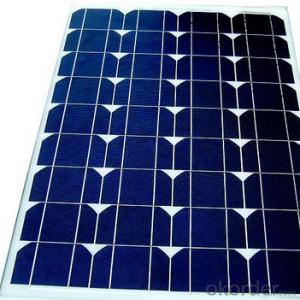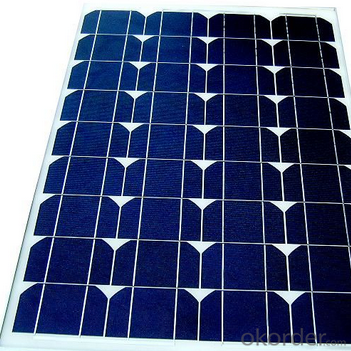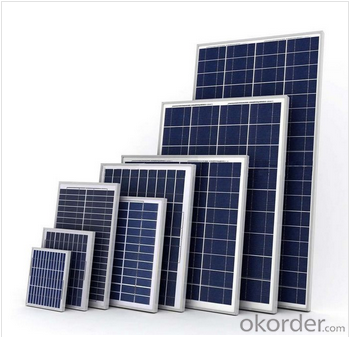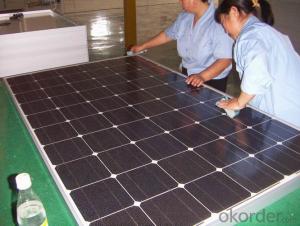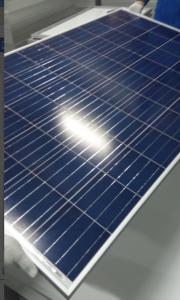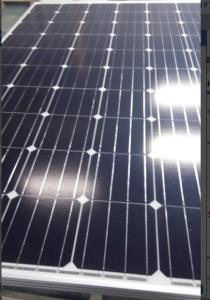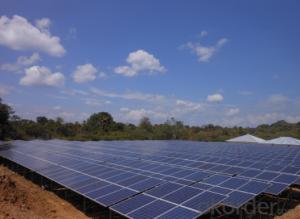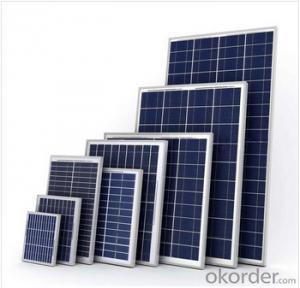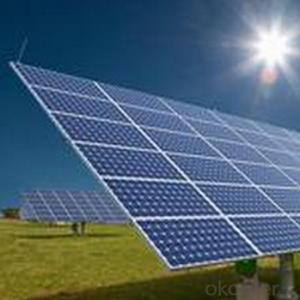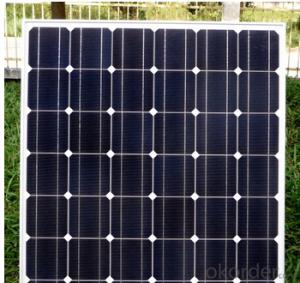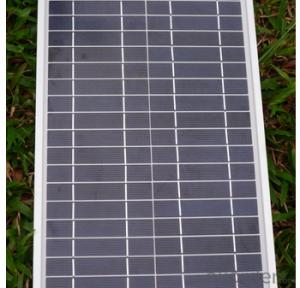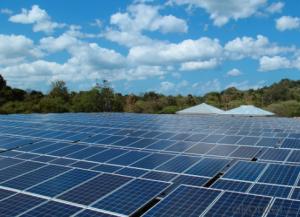High Power Poly Solar Panel/Module - Ice 40 for The Home
- Loading Port:
- China main port
- Payment Terms:
- TT OR LC
- Min Order Qty:
- 200 watt
- Supply Capability:
- 50000 watt/month
OKorder Service Pledge
OKorder Financial Service
You Might Also Like
Instruction
Format : 156 mm × 156 mm ± 0.5 mm
Thickness: 210 μm ±40 μm
Feature
1. High efficiency and High power.
2. Long-term electrical stability.
3. Lowest price and Fastest delivery.
4. Good quality and best service.
5. Bulk supply
Images
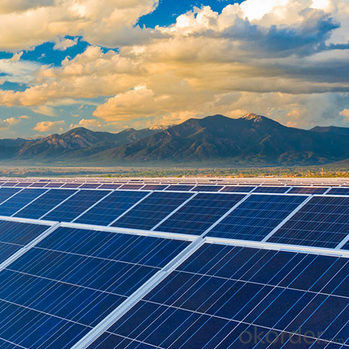
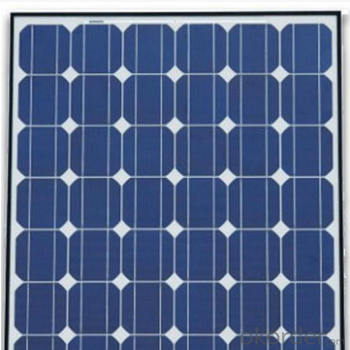
Specification
Electrical Characteristic of Mono Solar Cells
Model Type | |
Peak Power-Pmax(W) | 185 |
Open Circuit Voltage-Voc(V) | 44.2 |
Maximum Power Voltage-Vmp(V) | 36 |
Short Circuit Current-Isc(A) | 5.4 |
Maximum Power Current-Imp(A) | 5 |
Maximum System Voltage | 1000V DC |
Maximum Series Fuse Rating | 10A |
Power Tolerance | -1~+3% |
Temperature Coefficients of Pmax | -0.45%/℃ |
Temperature Coefficients of Voc | -0.348%/℃ |
Temperature Coefficients of Isc | 0.031%/℃ |
Nominal Operating Cell Temperature | 44.5±2℃ |
Standard Testing Condition(STC) | Irradiance:1000W/m²;Temperature:25℃;AM=1.5 |
Qualification Test Parameters | |
Operating Temperature | -40℃~+85℃ |
Storage Temperature | -40℃~+85℃ |
Pressure Bearing | ≥5400Pascal/m² |
Wind Bearing | ≥5400Pascal/m² |
Mechanical Characteristics | |
Cell Size | Mono 125*125mm±0.5 |
No.of Cells | 72pcs(6*12) |
Dimension | 1580*808*40mm |
Weight | 15.5Kg |
Glass | 3.2mm High Transmission,Low Iron |
Frame | Anodized Aluminum Alloy |
Junction Box | IP65Rated |
Internal Diodes | 3 Bypass Diodes |
Cable | 1*4.0mm² Length 900mm |
FAQ
We have organized several common questions for our clients,may help you sincerely:
1. What’s price per watt?
A: It’s depends on the quantity, delivery date and payment terms of the order. We can talk further about the detail price issue. Our products is high quality with lower price level.
2. Can you tell me the parameter of your solar cells?
We have different series of cells with different power output, both from c-si to a-si. Please take our specification sheet for your reference.
3. How do you pack your products?
We have rich experience on how to pack the panels to make sure the safety on shipment when it arrives at the destination.
- Q: Can solar panels be installed on a barn or shed?
- Yes, solar panels can be installed on a barn or shed. In fact, barns and sheds often have large roof spaces that are ideal for solar panel installation. This allows the building to generate its own clean and renewable energy, reducing electricity costs and environmental impact.
- Q: How do solar panels affect the overall energy security of a building?
- Solar panels can greatly enhance the overall energy security of a building. By harnessing the sun's energy, solar panels provide a reliable and renewable source of electricity. This reduces dependence on traditional fossil fuels and the associated risks of price fluctuations, supply disruptions, and geopolitical tensions. With solar panels, buildings can generate their own clean energy, ensuring a more stable and self-sufficient power supply, which ultimately contributes to a stronger energy security profile.
- Q: Can solar panels be used to power a theme park?
- Yes, solar panels can be used to power a theme park. Solar energy is a renewable and sustainable source of power that can be harnessed to meet the energy needs of various establishments, including theme parks. By installing a sufficient number of solar panels, a theme park can generate enough electricity to power rides, lighting, and other facilities, while also reducing its carbon footprint and operating costs.
- Q: What Are Solar Panels Made Of?
- Learn to google and learn to ask a 3 part question instead of asking 3
- Q: Are there any noise concerns with solar panels?
- No, there are no noise concerns with solar panels. Solar panels produce electricity by converting sunlight into energy and do not generate any noise during their operation.
- Q: Can solar panels be installed on flat surfaces?
- Yes, solar panels can be installed on flat surfaces. However, it is more common to install them on angled surfaces such as rooftops or mounting structures to maximize their efficiency and exposure to sunlight.
- Q: Can solar panels be used for large-scale power generation?
- Yes, solar panels can definitely be used for large-scale power generation. With advancements in technology and decreasing costs, solar power has become a viable option for utility-scale projects. Large solar farms comprising thousands of panels are being built around the world to generate electricity on a massive scale. These solar installations have the potential to provide clean and sustainable energy for cities, industries, and even entire regions.
- Q: Have a 20V 40W solar panel and it is attach to two backup batteries. Just want to know know how many watt of inverter do I need?
- 500 Watt Solar Panel
- Q: Can solar panels be used to power electric vehicles?
- Yes, solar panels can be used to power electric vehicles. Solar panels can convert sunlight into electricity, which can then be stored in a battery and used to power an electric vehicle. This helps reduce dependence on fossil fuels and promotes sustainable transportation.
- Q: how does solar panels work?
- Solar panels collect solar radiation from the sun and actively convert that energy to electricity. Solar panels are comprised of several individual solar cells. These solar cells function similarly to large semiconductors and utilize a large-area p-n junction diode. When the solar cells are exposed to sunlight, the p-n junction diodes convert the energy from sunlight into usable electrical energy. The energy generated from photons striking the surface of the solar panel allows electrons to be knocked out of their orbits and released, and electric fields in the solar cells pull these free electrons in a directional current, from which metal contacts in the solar cell can generate electricity. The more solar cells in a solar panel and the higher the quality of the solar cells, the more total electrical output the solar panel can produce. The conversion of sunlight to usable electrical energy has been dubbed the Photovoltaic Effect. The photovoltaic effect arises from the properties of the p-n junction diode, as such there are no moving parts in a solar panel.
Send your message to us
High Power Poly Solar Panel/Module - Ice 40 for The Home
- Loading Port:
- China main port
- Payment Terms:
- TT OR LC
- Min Order Qty:
- 200 watt
- Supply Capability:
- 50000 watt/month
OKorder Service Pledge
OKorder Financial Service
Similar products
Hot products
Hot Searches
Related keywords
